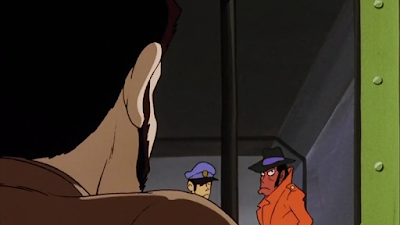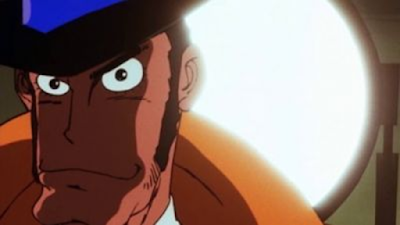Note: This post contains affiliate links. I may receive a small commission if you make a purchase through one of them. Thank you for supporting my blog!
Our first introduction to Koichi Zenigata was, technically, at the very beginning of Lupin the Third Part 1. He was a presence, but not the key antagonist. We got a taste of what he's doing there and why — his belief that the two are destined to be at odds, as well as his links to the literary Zenigata and Lupin the First's Ganimard and "Herlock Sholmes." (More on that in my first blog post in the series.) But he's not the chief antagonist there so much as an extra wrinkle. His appearance is more for the sake of crafting the universe up front.
In "One Chance for a Prison Break," we truly see Lupin and Zenigata go toe-to-toe as equals, rather than Zeni getting comically thwarted as an afterthought. It kicks off a long history of rivalry mixed with respect, bloodthirsty intent tempered by actual investment.
The Long Game
The episode starts theoretically at an end: Lupin wrapping up a successful heist with Fujiko. With embarrassingly keen timing, Zenigata and his men swoop in at the last minute, peppering Lupin with tranq rounds and carting him off to prison.
Immediately, Lupin goes off. He's not Lupin, he's one of the guards. The real Lupin has disguised both himself and the guard and swapped places. There's a hot second of concern, but Zenigata finally confirms that, yes, they caught the real deal and he's just making a scene. Lupin is bundled into a straitjacket and locked up, with his execution scheduled for a year hence.
Yeah. Execution. That's the only thing that will satisfy Zenigata. Kill the son of a bitch. Put a pin in that.
Time goes on, and Lupin attempts... well, nothing. Except growing a hell of a beard and gettin' gaunt, and continue to inure Zenigata and the guards to the whole "I'm not the real Lupin" rant. Fujiko makes repeated attempts to break him out, with Jigen stopping her each time — Lupin knows what he's doing, Jigen assures her. But even Jigen begins to wonder what's up, finally disguising himself as a Buddhist monk and paying a visit as his partner's execution draws near. Lupin assures him this is all according to keikaku.
Hell, even Zenigata is freaking out at this point. A fellow officer points out that it's almost like he wants Lupin to escape. Put a pin in that, too.
Finally, the day comes, and we discover that Lupin hasn't been idle. He's been... growing out one fingernail. Now that it's razor-sharp, he can cut his way out of his straitjacket, shave half his face, and (unshaven side forward) lure a guard in. Then he really does pull the ol' switcheroo. As the prisoner is screaming that he's not the real Lupin, that the real Lupin has pulled a switch and is now posing as a guard... oh, right. That. Of course, as planned, Zenigata rolls his eyes and waves it off.
Lupin almost gets away with it, too... except that he accidentally refers to the prison having a gas chamber rather than an electric chair. That gives the game up, but Lupin still makes his escape — taking the time to point out that, yeah, he could have escaped at any time. But since Zenigata embarrassed him by thwarting him at the last second, Lupin wanted to do the same to him.
There's just one down side to Lupin's spite-motivated plan: the forest where he and Fujiko hid their acquisition got mowed down in the intervening year.
Adaptability
As with previous episodes, "One Chance for a Prison Break" was adapted from Monkey Punch's original manga. Specifically, the very second installment. A few changes were made here and there, chief among them being the presence of Jigen (who hadn't been introduced in the manga yet). Lupin was also due to be executed by gas chamber in the manga — hence his (not-so-)fatal slip-up in the anime.
But the adaptation action doesn't end there. This episode (and by extension the manga chapter) takes inspiration from parts of the very first Arséne Lupin collection. After being arrested in his first story ("The Arrest of Arséne Lupin," 1905), he sends a letter from prison claiming he'll be around before his trial for another round of light thievery ("Arséne Lupin in Prison," 1905).
It all kicks off in the appropriately-titled "The Escape of Arséne Lupin" (1906), when Ganimard allows Lupin to affect his jailbreak. The plan was to use the opportunity to nab Lupin's co-conspirators in the process... except that, aware he's being watched, the thief simply pops out for a meal and then returns to prison. On the same day, a lookalike was arrested and summarily released. But at trial, Ganimard becomes convinced that Lupin and the lookalike got switched around that day, and the Lupin on the stand is in fact the lookalike. And so, he's let go.
Except... whoops, it really was Lupin all along. His cohorts made sure the lookalike got in the mix on the day of his escape, and Lupin used dieting and drugs (ah, the early 20th century) to make himself look enough like the lookalike to cast doubt in Ganimard's mind.
Fortunately for The Third's health, we have it confirmed throughout the series that he prefers to use a Hollywood level makeup kit that he stows... somewhere.
Eternal Rivalry
The relationship between Lupin and Zenigata is, frankly, one of the best things in anime. It's interpreted a lot of different ways — full disclosure, I personally approach them as either friends or familial. Your mileage may vary, that's just what's here. Regardless.
I touched in my post on "Is Lupin Burning?" on the original Arséne Lupin's view of detectives and thieves (as he explained to Herlock Sholmes), and how we see that reflected throughout Lupin the Third. It's one of my favorite quotes from Leblanc's original stories: to paraphrase, the idea that the two are on opposite sides of a fence, with directly opposing purposes in life, and that they may occasionally meet and cross paths, but the fence may never be jumped. It's great. I love it.
Zenigata has a moment of pause in "Is Lupin Burning?" where he speculates (without actually verbalizing) on how life would be if he, a Zenigata, were not fated to chase and capture a Lupin. As time goes on, he doesn't really have to speculate, since the two are on the same side more and more as Lupin's ideals and characterization change. You see it in The Castle of Cagliostro, you absolutely see it in The First, and you get a big weird bite of it in 2001's Alcatraz Connection... where Lupin effects another jailbreak using Zenigata, his weird American partner, and a hearse.
Part V is where this really shines, though. It's a season devoted to testing and pulling on the core cast's interpersonal relationships, questioning them, and ultimately strengthening them. That includes Zenigata's obsession with bringing Lupin in. Koichi Yamadera gets to chew on possibly Zenigata's greatest monologue ever: where he explains exactly why he's doing this, filling in that blank from nearly 50 years prior.
As much as I want to just copy-paste it here, it's so much better to see it on your own.
Part IV has another impressive jailbreak, this time out of a bespoke prison designed from Zenigata's own specs. I won't go into it here (maybe someday on the blog); the short version is, there's some serious power creep between these two. Driving home that Zenigata really is a high-level Lawful Good Paladin when so much of his time is spent being thwarted can be difficult. His goofiness comes from his personality, not from any lack of skill. Zenigata is good. It's just Lupin is better.
Up next, we introduce a familiar face who's been notably absent so far. And he's got a bone to pick with Lupin, too.





0 comments:
Post a Comment